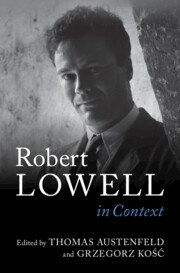Book contents
- Robert Lowell in Context
- Robert Lowell In Context
- Copyright page
- Dedication
- Contents
- Contributors
- Acknowledgments
- Abbreviations
- Introduction
- Part I Places
- Part II American Politics, American Wars
- Part III Some Literary Models
- Chapter 8 Classics
- Chapter 9 Melville
- Chapter 10 Plaints
- Part IV Contemporaries
- Part V Life, Illness, and the Arts
- Part VI Reputation and New Contexts
- Further Reading
- Index
Chapter 10 - Plaints
from Part III - Some Literary Models
Published online by Cambridge University Press: 28 March 2024
- Robert Lowell in Context
- Robert Lowell In Context
- Copyright page
- Dedication
- Contents
- Contributors
- Acknowledgments
- Abbreviations
- Introduction
- Part I Places
- Part II American Politics, American Wars
- Part III Some Literary Models
- Chapter 8 Classics
- Chapter 9 Melville
- Chapter 10 Plaints
- Part IV Contemporaries
- Part V Life, Illness, and the Arts
- Part VI Reputation and New Contexts
- Further Reading
- Index
Summary
Lowell’s attraction to the sonnet was historical and architectural and yet the form itself, one he wrestled with above all others, had at its origin desire and unrequited love. For Lowell, the little song of the sonnet worked well as a house for the complaint, “an expression of grief, a lamentation, a plaint” (OED). As far back as the fourteenth century, Chaucer used it as a title for poems (“The Complaint unto Pity,” c. 1368) and complaints hold both an expression of torment or grief and a song. In the 1946 volume, Lord Weary’s Castle, Lowell uses the sonnet form to express such a plaint, in this case as a measure to aid in indirect self-reflection (“The North Sea Undertaker’s Complaint”). Life Studies (1959) finds Lowell still ruminating on the sonnet form and its expressive capacities, as we see in the triple sonnet “Beyond the Alps,” pivoting as it does between subjects and acting as an opportunity for historical rather than personal insight. Day by Day (1977) roots itself in the personal and introduces looser forms. The sonnet’s acoustic energies are not bottled here but the poems participate in sonnet-like thinking.
- Type
- Chapter
- Information
- Robert Lowell In Context , pp. 108 - 118Publisher: Cambridge University PressPrint publication year: 2024

